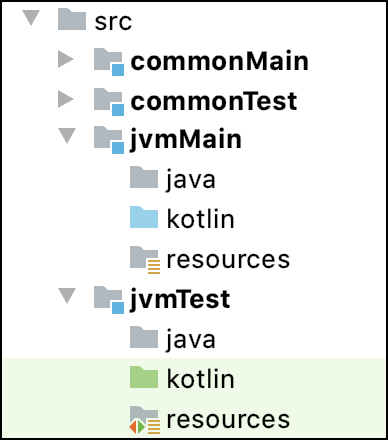配置编译
Kotlin 多平台项目使用编译 (compilation) 来生成产物 (artifact)。每个目标 (target) 可以有一个或多个编译,例如,用于生产和测试目的。
对于每个目标,默认的编译包括:
- 用于 JVM、JS 和 Native 目标的
main和test编译。 - 每个 Android 构建变体 的 编译,用于 Android 目标。

如果你需要编译除生产代码和单元测试之外的其他内容,例如,集成测试或性能测试,你可以创建一个自定义编译。
你可以配置如何在以下位置生成产物:
配置所有编译
此示例配置了一个跨所有目标通用的编译器选项:
- Kotlin
- Groovy
kotlin {
compilerOptions {
allWarningsAsErrors.set(true)
}
}
kotlin {
compilerOptions {
allWarningsAsErrors = true
}
}
配置一个目标的编译
- Kotlin
- Groovy
kotlin {
jvm {
compilerOptions {
jvmTarget.set(JvmTarget.JVM_1_8)
}
}
}
kotlin {
jvm {
compilerOptions {
jvmTarget = JvmTarget.JVM_1_8
}
}
}
配置一个特定的编译
- Kotlin
- Groovy
kotlin {
jvm {
val main by compilations.getting {
compileTaskProvider.configure {
compilerOptions {
jvmTarget.set(JvmTarget.JVM_1_8)
}
}
}
}
}
kotlin {
jvm {
compilations.main {
compileTaskProvider.configure {
compilerOptions {
jvmTarget = JvmTarget.JVM_1_8
}
}
}
}
}
创建一个自定义编译
如果你需要编译除生产代码和单元测试之外的其他内容,例如,集成测试或性能测试,创建一个自定义编译。
例如,要为 jvm() 目标的集成测试创建一个自定义编译,请向 compilations 集合添加一个新条目。
对于自定义编译,你需要手动设置所有依赖项。自定义编译的默认源集不依赖于 commonMain 和 commonTest 源集。
- Kotlin
- Groovy
kotlin {
jvm() {
compilations {
val main by getting
val integrationTest by compilations.creating {
defaultSourceSet {
dependencies {
// Compile against the main compilation's compile classpath and outputs:
implementation(main.compileDependencyFiles + main.output.classesDirs)
implementation(kotlin("test-junit"))
/* ... */
}
}
// Create a test task to run the tests produced by this compilation:
tasks.register<Test>("integrationTest") {
// Run the tests with the classpath containing the compile dependencies (including 'main'),
// runtime dependencies, and the outputs of this compilation:
classpath = compileDependencyFiles + runtimeDependencyFiles + output.allOutputs
// Run only the tests from this compilation's outputs:
testClassesDirs = output.classesDirs
}
}
}
}
}
kotlin {
jvm() {
compilations.create('integrationTest') {
defaultSourceSet {
dependencies {
def main = compilations.main
// Compile against the main compilation's compile classpath and outputs:
implementation(main.compileDependencyFiles + main.output.classesDirs)
implementation kotlin('test-junit')
/* ... */
}
}
// Create a test task to run the tests produced by this compilation:
tasks.register('jvmIntegrationTest', Test) {
// Run the tests with the classpath containing the compile dependencies (including 'main'),
// runtime dependencies, and the outputs of this compilation:
classpath = compileDependencyFiles + runtimeDependencyFiles + output.allOutputs
// Run only the tests from this compilation's outputs:
testClassesDirs = output.classesDirs
}
}
}
}
在其他情况下,你也需要创建一个自定义编译,例如,如果你想在最终产物中组合用于不同 JVM 版本的编译,或者你已经在 Gradle 中设置了源集并想迁移到多平台项目。
在 JVM 编译中使用 Java 源码
当使用 项目向导 创建项目时,默认会创建 Java 源码并将其包含在 JVM 目标的编译中。
Java 源码文件放置在 Kotlin 源码根目录的子目录中。例如,路径是:

公共源集不能包含 Java 源码。
由于当前的限制,Kotlin 插件替换了 Java 插件配置的一些任务:
- 目标的 JAR 任务代替
jar(例如,jvmJar)。 - 目标的测试任务代替
test(例如,jvmTest)。 - 资源由编译的等效任务处理,而不是
*ProcessResources任务。
此目标的发布由 Kotlin 插件处理,不需要特定于 Java 插件的步骤。
配置与原生语言的互操作性
Kotlin 提供了与原生语言的互操作性和 DSL 来为特定编译配置它。
| 原生语言 (Native language) | 支持的平台 (Supported platforms) | 注释 (Comments) |
|---|---|---|
| C | 除 WebAssembly 之外的所有平台 | |
| Objective-C | Apple 平台 (macOS, iOS, watchOS, tvOS) | |
| Swift via Objective-C | Apple 平台 (macOS, iOS, watchOS, tvOS) | Kotlin 只能使用标有 @objc 属性的 Swift 声明。 |
一个编译可以与多个原生库交互。使用定义文件或构建文件的 cinterops 块中的可用属性配置互操作性:
- Kotlin
- Groovy
kotlin {
linuxX64 { // Replace with a target you need.
compilations.getByName("main") {
val myInterop by cinterops.creating {
// Def-file describing the native API.
// The default path is src/nativeInterop/cinterop/<interop-name>.def
definitionFile.set(project.file("def-file.def"))
// Package to place the Kotlin API generated.
packageName("org.sample")
// Options to be passed to compiler by cinterop tool.
compilerOpts("-Ipath/to/headers")
// Directories to look for headers.
includeDirs.apply {
// Directories for header search (an equivalent of the -I<path> compiler option).
allHeaders("path1", "path2")
// Additional directories to search headers listed in the 'headerFilter' def-file option.
// -headerFilterAdditionalSearchPrefix command line option equivalent.
headerFilterOnly("path1", "path2")
}
// A shortcut for includeDirs.allHeaders.
includeDirs("include/directory", "another/directory")
}
val anotherInterop by cinterops.creating { /* ... */ }
}
}
}
kotlin {
linuxX64 { // Replace with a target you need.
compilations.main {
cinterops {
myInterop {
// Def-file describing the native API.
// The default path is src/nativeInterop/cinterop/<interop-name>.def
definitionFile = project.file("def-file.def")
// Package to place the Kotlin API generated.
packageName 'org.sample'
// Options to be passed to compiler by cinterop tool.
compilerOpts '-Ipath/to/headers'
// Directories for header search (an eqivalent of the -I<path> compiler option).
includeDirs.allHeaders("path1", "path2")
// Additional directories to search headers listed in the 'headerFilter' def-file option.
// -headerFilterAdditionalSearchPrefix command line option equivalent.
includeDirs.headerFilterOnly("path1", "path2")
// A shortcut for includeDirs.allHeaders.
includeDirs("include/directory", "another/directory")
}
anotherInterop { /* ... */ }
}
}
}
}
Android 编译
默认情况下,为 Android 目标创建的编译与 Android 构建变体 相关联:对于每个构建变体,都会创建一个具有相同名称的 Kotlin 编译。
然后,对于为每个变体编译的每个 Android 源集,都会创建一个 Kotlin 源集,该源集名称以目标名称为前缀,例如,用于 Android 源集 debug 的 Kotlin 源集 androidDebug 和名为 androidTarget 的 Kotlin 目标。这些 Kotlin 源集会相应地添加到变体的编译中。
默认源集 commonMain 会添加到每个生产(应用程序或库)变体的编译中。commonTest 源集也会以类似的方式添加到单元测试和插桩测试变体的编译中。
kapt 的注解处理也受支持,但由于当前的限制,它要求在配置 kapt 依赖项之前创建 Android 目标,这需要在顶层的 dependencies {} 块中完成,而不是在 Kotlin 源集依赖项中完成。
kotlin {
androidTarget { /* ... */ }
}
dependencies {
kapt("com.my.annotation:processor:1.0.0")
}
源集层次结构的编译
Kotlin 可以使用 dependsOn 关系构建源集层次结构。

如果源集 jvmMain 依赖于源集 commonMain,则:
- 只要为特定目标编译
jvmMain,commonMain也会参与该编译,并被编译为相同的目标二进制形式,例如 JVM 类文件。 jvmMain的源文件“看到”commonMain的声明,包括内部声明,并且还看到commonMain的 依赖项,即使那些被指定为implementation依赖项。jvmMain可以包含commonMain的 expected 声明 的平台特定实现。commonMain的资源始终与jvmMain的资源一起处理和复制。jvmMain和commonMain的 语言设置 应该一致。
语言设置的一致性检查方式如下:
jvmMain应设置大于或等于commonMain的languageVersion。jvmMain应启用commonMain启用的所有不稳定的语言特性(对缺陷修复特性没有这样的要求)。jvmMain应使用commonMain使用的所有实验性注解。apiVersion、缺陷修复语言特性和progressiveMode可以任意设置。
在 Gradle 中配置 Isolated Projects 功能
此功能是 Experimental 的,目前处于 Gradle 的 pre-alpha 状态。 仅将其与 Gradle 8.10 或更高版本一起使用,并且仅用于评估目的。该功能可能随时被删除或更改。 我们欢迎您在 YouTrack 中提供有关此功能的反馈。 需要选择加入(请参阅下面的详细信息)。
Gradle 提供了 Isolated Projects 功能, 通过将各个项目彼此“隔离”来提高构建性能。此功能分离了项目之间的构建脚本和插件,允许它们安全地并行运行。
要启用此功能,请按照 Gradle 的说明设置系统属性。
有关 Isolated Projects 功能的更多信息,请参阅 Gradle 的文档。